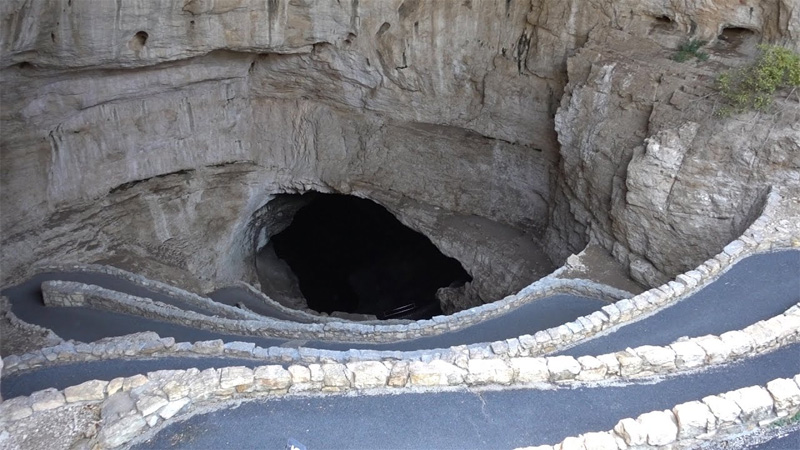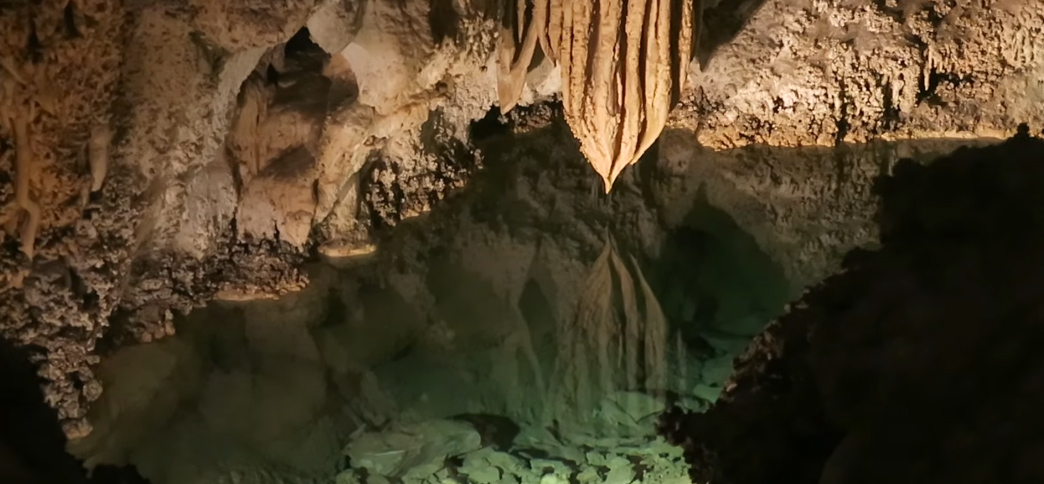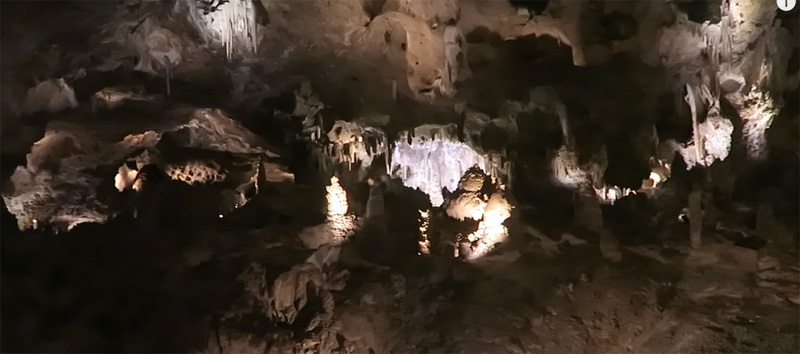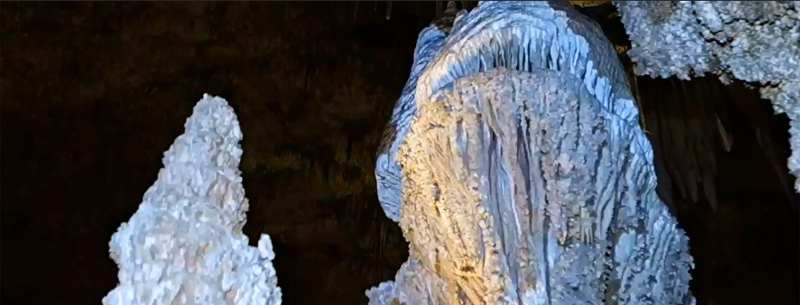I don’t do caves. In my cheerful mind, they’re all unstable mining tunnels that could collapse on me at any moment, leaving me to suffocate to death in a stone coffin. So although friends and family have raved about the wonders of Carlsbad Caverns National Park in New Mexico, there were logistical issues. For example, they were underground.
The 1959 movie version of Journey to the Center of the Earth was filmed in Carlsbad Caverns and supports my claustrophobic paranoia: caves are full of dangers and the odds of reemerging are questionable. I first came to this conclusion while hurtling into the black depths of the earth on board a decrepit, open-topped ‘train’ to see cave paintings in France. I was maybe seven, I think I was in Dordogne, and everyone else seemed fine with their imminent deaths. While the cave paintings made a strong impression, the fear made a stronger one.

As a teenager, I actually enjoyed visiting another cave (also in France) and the key difference was that it was an airy cavern. Also, visitors got serenaded by Orff’s Carmina Burana, which was equal parts dramatic and distracting.
So Carlsbad Caverns… Right there, in the name, it promised to be massive. So I wasn’t feeling too apprehensive as we approached the entrance. Then we passed the following sign.
‘Your recovery dollars at work Carlsbad elevator shaft rehabilitation.’
“They’re fixing the elevator? I don’t want to go into a shaft that needs rehabilitating.”
“I’m sure they’re done with that now,” I was assured.
Not so much. Two of the elevators had paper signs taped to the door indicating they were closed for use. Instead of hightailing it back into the Chihuahuan Desert (full of much more appealing things, such as cacti and twenty-four species of snake), I walked up to the ticket counter. There I was grilled about whether I’d traveled to Europe in the last fifteen years and if so, to which countries? The list of those not visited would have been shorter. But what did Carlsbad Caverns have against Europe?
Plenty. White nose syndrome, a fungus that eats the skin and wings of bats, originated there.

White nose syndrome has decimated the bat population, killing roughly 6.7 million bats since 2006. It has spread to the eastern states in the United States and is creeping westwards. Bats transmit the disease to each other, but scientists believe it likely that people can spread it too. Either cavers or visitors to caves transport the disease on their clothing or gear.
Thanks to my phobia, I could safely say that I had not been in caves or mines in the affected areas within the last fifteen years. If you cannot say the same, hold off on visiting, because it hasn’t yet reached Carlsbad and its 400,000 Mexican free-tailed bats.
So why is white-nose syndrome a big deal?
- Bats make up one-fifth of all the mammals on the planet. (Yes, really).
- They eat gazillions of bugs that could be snacking on you.
- Some species are perilously near extinction.
As we stepped into the elevator, I was more concerned about my own survival. The small box was accessorized with windows, to showcase the rock tube that plunged 750 feet toward the center of the earth. If that distance were above ground, it would be four and half times the height of Niagara’s Horseshoe Falls.
Mercifully, the descent was fairly fast. We stepped out into a well-lit waiting area that looked surprisingly similar to the building above. A ranger warned us not to touch any of the formations and that voices carried for up to a quarter-mile. Translation: if I let out so much as a cowardly whimper, everybody in the vicinity would know. I had some pride… right?
I suctioned down musty air and felt my skin chill as the dampness sunk in. Even with lighting, moving along the path was like stumbling toward your bathroom in the middle of the night: you have a general idea of where objects are but it’s still disconcerting. Then my eyes adjusted to the gloom and I forgot all about the 750 feet separating me from the surface.
The Big Room
The Big Room lives up to its name. It’s the length of ten football fields, making it the largest cave room in the nation. The ceiling, 225 feet overhead, is adorned with sharp stalactites that resemble javelins. It’s like wandering onto the set of MTV Cribs: Grotto Edition.
There are two routes around the Big Room. The longer one gives you an appreciation of the cavern’s scale, but I’d recommend the short loop to anyone with mobility issues. You still see the majority of the rock formations.

When stalactites and stalagmites meet in the middle, they form pillars or columns.
But what really struck me about Carlsbad were the draperies: rock formations that look like fabric. It’s as if someone let Michaelangelo loose down here, with a chisel.
Many of the formations have evocative names like the Dolls’ Theater or the Painted Grotto. There’s even an underground lake – Mirror Lake.
How were the 110 plus caves of Carlsbad made?
240-280 million years ago, the southeastern region of New Mexico was covered by a shallow, inland sea. The area around Carlsbad was part of the Capitan Reef. Over time, the reef material was eroded by sulfuric acid, leaving caves behind. Some of the caves even have fossils, providing proof of their aquatic past.
Exploring the Big Room takes between one to two hours, depending on which route you choose. There are also six different ranger-led tours, which take you off the beaten path (reservations recommended). I figured I’d been adventurous enough, so made a beeline for the elevators.

Another couple stepped in with us. As the elevator rose, the husband peppered the operator with questions. “Is there an emergency exit?” he asked.
“Nope.”
“Does the elevator ever get stuck? And if so, what’s the longest amount of time you’ve been stuck in here?”
“About an hour,” the operator replied.
The man’s wife was watching, as I grew paler and more wild-eyed with each question.
She patted me on the arm and cocked her head toward her husband.
“You can hit him if you want!”
Thankfully, the doors binged open. I dove out into the light, grateful to have experienced Carlsbad Caverns, but even more grateful to have safely left them!
- Check out the NPS site for prices, operating hours, etc. Please note that strollers are not permitted – bring a baby carrier instead. Also, Fido is not welcome.
- Understandably, there’s not much around Carlsbad Caverns National Park. As far as dining options go, we recommend Yellow Brix at 201 N. Canal Street, in Carlsbad. Order anything that comes with the house-made potato chips!
